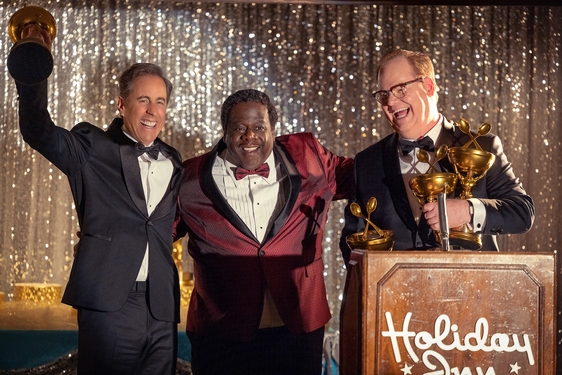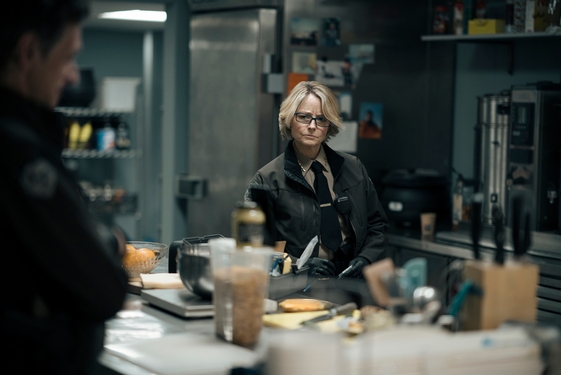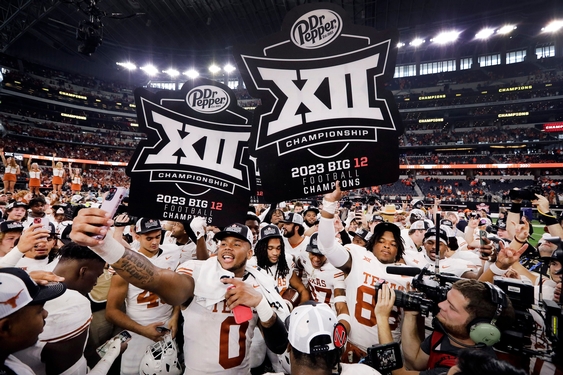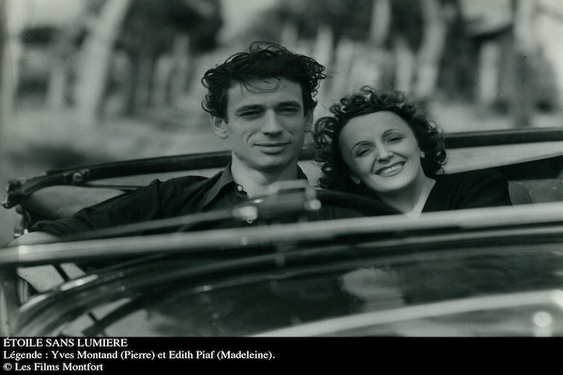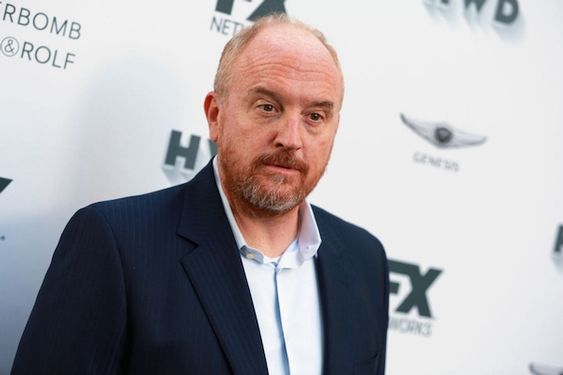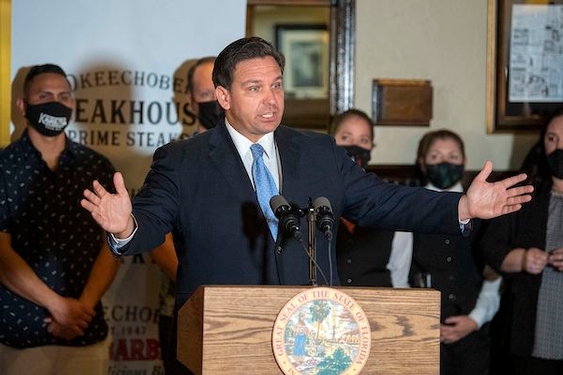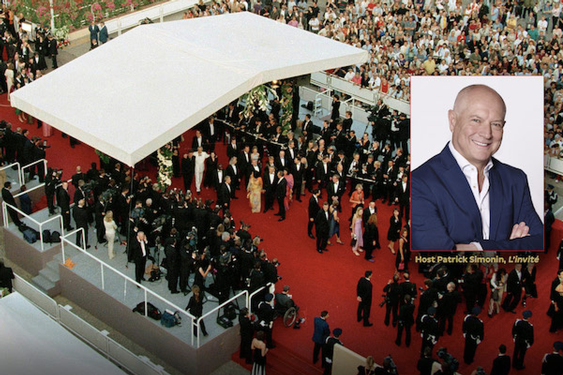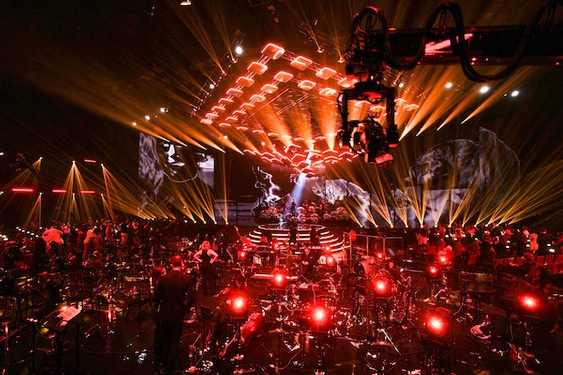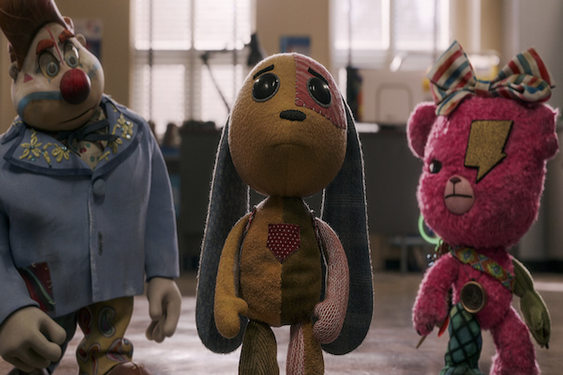Someday, when the dust settles on the turbulent, game-changing history of early 21st-century media — at that far-off point when the use of jargon like “game-changing” is met swiftly, and by decree, with a light prison sentence — let’s hope this small, tossed-off moment is not forgotten: On Jan. 11, 2015, during their opening monologue at the normally boozy and irrelevant Golden Globe Awards, hosts Tina Fey and Amy Poehler pretended they didn’t have enough time to recognize the TV people in attendance and led the audience in a call-and-response: “When we say, ‘Movies,’ you say, ‘Awesome!’ …”
The audience, composed of filmmakers and movie stars and plenty of TV folk, did this, heartily.
Then Fey and Poehler shouted:
“When we say, ‘TV,’ you say, ‘Better!’ …”
And the response — alas, the game-changer — that came from that crowd was … roughly equivalent. Not confused and not angry. Not dissolving into laughter once they had gotten the joke, as you might have witnessed a generation ago, when everyone there would have known the decades-old pecking order of pop-cultural gravitas went something like: 1. Movies, 2. Music and 3.TV. No, instead it didn’t seem as if anyone in that crowd missed a beat, and the response of “Better!” was very clear.
Perhaps because, at least perception-wise, TV has taken the No. 1 slot. “Better!” is no punch line. It’s fact.
Arguably.
Probably.
Unless you’ve been seated beside Matthew McConaughey on a universe-traversing space journey for the past decade — an experience, as seen in “Interstellar,” that needed a wide-screen canvas but might have played comfortably episodic as an HBO miniseries — you know this. It should not come as news that Hollywood’s addiction to franchise films and TV’s current, gutsier Golden Age collided, resulting in upheaval. The way we watch stories, consume images or just think of the relationship between TV and film has grown inverted, fuzzier. And yet, during that time, we have also continued to tell ourselves that the big screen, and the motion picture industry, is where greatness and timelessness reside, and TV, seemingly ephemeral and easily ignored, is second-class culture. It’s a weirdly decorous agreement. And I hate to be a rude dinner guest and note the elephant in the room at the least opportune time — i.e., Oscar season — but so be it.
For me at least, and likely many of you, the past 12 months has held far knottier truths. The movies may still stake a claim to the history and glamour of a beloved art form. But I have finally come to grips with the sense that the theatrical experience, as a special thing, as a hallowed ground, now stands slightly behind the home experience — for storytelling, for relevance, even for specialness.
Which is why even a crack made during an awards show about the TV industry’s back-seat status is now ironic. Or why, on the current season of “American Horror Story,” when Jessica Lange, playing a Marlene Dietrich-like reclusive star relegated to a Florida freak show, makes a joke about aging movie actresses who lower themselves to TV stardom, it’s not a self-conscious, self-flagellating line, but full of vengeful glee.
That old, playfully combative animosity between big and small screens is a lie, more formality now than reality.
Be it a movie that plays better on TV, or TV that feels more like a movie, I often choose a small screen now. As a movie-lover, I appreciate the immersive power of a theater, and most weekends, I see a couple of movies in theaters. But if I am honest with myself, watching movies via video on demand services on a small screen has started to feel just fine. In fact, a few of my favorite films from the past year — the Australian horror film “The Babadook,” the Swedish charmer “We Are the Best,” the Sundance favorite “Frank” — I decided to watch on a small screen, at home. Not months after these movies played theaters, either. I streamed them, on the same day I could have gone to a theater to see them. And I wasn’t alone: The last-minute release of “The Interview” on VOD gathered $15 million in a few days, and the surprise hit of the summer, “Snowpiercer,” was more VOD smash than theatrical success. In fact, in 2014 VOD sales broke $1.5 billion for the first time, while theater attendance in the United States hit a 20-year low.
Meanwhile, the HBO blockbuster, cinematic “Game of Thrones” will be shown in Imax theaters for two weeks, starting Jan. 30. And that makes perfect sense to me.
Frankly — OK, I’ve gone from rude dinner guest to drunk, rude dinner guest — as much as I loved many of the current Oscar contenders, nothing I saw in theaters was as exciting as “The Americans” on FX, or “Broad City” on Comedy Central, or “True Detective” on HBO. I have begun to look to the lineup on my TiVo and my Xbox with as much relish as the lineup at my neighborhood movie theater.
Still, it’s a schizophrenic mindset, not a settled, easy feeling.
Can you love the big screen and still look forward more to the small screen?
TV Me asks: Why go out of your way for another Oscar-season war picture like “Unbroken” when you’re still on the first season of “House of Cards” and never did finish Todd Haynes’ 2011 miniseries, “Mildred Pierce”? Then Movie Me replies: Because the communal movie experience is still special, and movie magic, evident even in a mediocre studio film, isn’t so evident on a small screen. Plus, that whole movie-love aura that the movies still gloat about, particularly at Oscar time, doesn’t have quite a TV equivalent, not yet. When Pauline Kael named her best-selling 1965 collection of reviews “I Lost It at the Movies,” she was winking, getting at the transcendent, salacious even sensual transformation that went on with a movie obsessive who tumbled happily into a cinematic tryst. But “I Lost It at Home on the Couch Watching ‘Snowpiercer’” just sounds filthy.
TV Me says: That old anticipation you used to feel for a new movie you now feel for the latest episode of a particularly engrossing series. You want to see the new “Avengers” movie, but you really want to know what happens next on that junkier, less weighty CW superhero series, “Arrow”; and while you can’t help but be curious about the new James Bond film in November, you can’t wait for Jan. 28, when “The Americans” is back.
But Movie Me says: Be honest. Even the most accomplished examples of the Golden Age of TV — “The Sopranos,” “The Wire,” etc. — lack the singular personality of the last Golden Age of Movies, the 1970s. When I asked Chicago filmmaker Joe Swanberg last year if he felt we were in a Golden Age of TV, he said no, for exactly that reason — there’s a lot of bad TV, and even the best lacks the distinctive visual stamp of great filmmaking.
He’s right.
On the other hand, Swanberg is a prime example of an independent filmmaker whose latest films, crafted with a movie house in mind, have found their niche as small-screen VOD smashes. And, of course, that could be the small screen of a PC, iPad, or smartphone. No matter the device, his talky, sincere 2013 hit “Drinking Buddies” comes across comfortably on a small screen. Just as the propulsive wit of Swedish filmmaker Lukas Moodysson’s “We Are the Best,” about three tweens who form a horrible rock band — a film that at times recalls the darting rhythms of 1950s Truffaut — would not be lost on a sizable, wide-screen HD home screen. Same for the ski-lodge family drama of “Force Majeure” and the compartmentalized pleasures of a quirky indie comedy like “Frank.”
Each had a theatrical run, each was made for the theater, and each, in a way, nicely complements the Golden Age of TV, lending an idiosyncratic personality that TV-produced-for-TV often lacks. So much so that, talking recently to Magnolia Pictures co-founder Eamonn Bowles, I asked if he feels like he’s in the TV business. Magnolia, a film distributor, after all, released most of those films simultaneously in theaters and on VOD.
“I see this as a film-content business now,” he said. “Our motto is we are agnostic about how people watch. Though to be honest, a lot of our films wouldn’t work in a lot of movie theaters anymore — because of the lack of a star, because it’s a foreign film, because it’s a carefully crafted drama — but might work as a hybrid theatrical/VOD release. That middle-ground movie, often what we deal in ...has become an untenable thing to distribute the old-fashioned way. But on a TV, there is the larger audience.”
Arguably, a better audience.
At the front lines of this perception shift, of course, are art-house theaters. In Chicago, that particularly means the Music Box Theatre in Lakeview and the Gene Siskel Film Center in the Loop. William Schopf, president of Music Box Films, which runs both the theater itself and the company’s film distribution wing, said that “The Babadook,” in December, enjoyed a couple of weekends of sold-out screenings despite being on video the same day it opened in theaters; he said “Snowpiercer” performed similarly, until being released two weeks later on VOD. He said that if a movie is released on VOD the same day it hits theaters, the Music Box wants a higher percentage of ticket sales. And that the theater’s 70 mm projection capabilities and ongoing $2 million in improvements are partly about taking precautions, about keeping a theater experience relevant.
But in the schizoid 21st century media landscape, the Music Box is also shrewd and diversified, releasing some of its film acquisitions on VOD, and even acquiring a handful of accomplished foreign TV series (such as “The Returned,” the French series about a small village dealing with the resurrection of a few dead residents).
Schopf couldn’t say if, by showing movies at the Music Box Theatre already available on VOD, or releasing movies on VOD that were acquired by Music Box Films, his company was cannibalizing its own art-house milieu, pushing more eyeballs to small screens: “I really don’t know. Clearly VOD cannibalizes DVDs, but an urban art house? Hard to know.”
Barbara Scharres, director of programming at the nonprofit Siskel, is less conflicted. Generally, she said, she avoids booking any movie that is also available on a smaller screen. “We don’t have statistics, and I wouldn’t even know how to measure something like this, but I hear from more and more people that they would rather stay home to watch a ‘Breaking Bad.’ And so, yes, it’s a frustration. Even worse, if a film is available on VOD first, it’s cheaper (to watch) at home, then the theater becomes more marginal.”
Last week, she was fuming: She booked Spike Lee’s latest movie to open in February, then, days later, received a notice from the film’s distributor that it would be on VOD — that afternoon.
But running an art house is like that now, she lamented: The Siskel booked the acclaimed Jean-Luc Godard 3-D movie “Goodbye to Language,” not available yet on a small screen. Then it booked the IFC film “Match,” which opens at the theater Friday and is already available on VOD.
Why book “Match” then, I asked.
“Because (VOD) is hard to avoid,” she said. “If I had a blanket rule against booking movies that were already available as VOD releases, if I said we would only show those experiences that you couldn’t already get on your TV or computer, we would cut ourselves out of a larger portion of everything out there. It’s not easy.”
It isn’t.
If I decide that I really like VOD, or merely binge-watch a season of “Veep” instead of attending “Goodbye to Language,” am I morally rejecting film as an institution?
Or is that a false ultimatum?
The Sundance Film Festival is going on in Park City, Utah. Eventually, despite its Hollywood stamp, many of the modest works that come from its famous hothouse will likely appear on your VOD streaming service in the next six months. Because VOD, and not movie theaters, is the new home of Sundance. Which is great if you never get to attend Sundance, but perhaps deflating if you picture a film festival as an incubator for big-screen talent.
Perhaps.
Watching “Birdman” again recently, admiring its celebrated and dazzlingly long, seamless takes, I told myself that regardless of how good TV can get, nothing on my TV will ever look quite as movielike as those moments in “Birdman.” But that’s only because I had forgotten those long, dazzling, seamless tracking shots in episodes of “True Detective,” which were directed by Cary Fukunaga, who won the 2009 award for best direction at, of course, Sundance.
———
©2015 Chicago Tribune
Visit the Chicago Tribune at chicagotribune.com
Distributed by Tribune Content Agency, LLC



